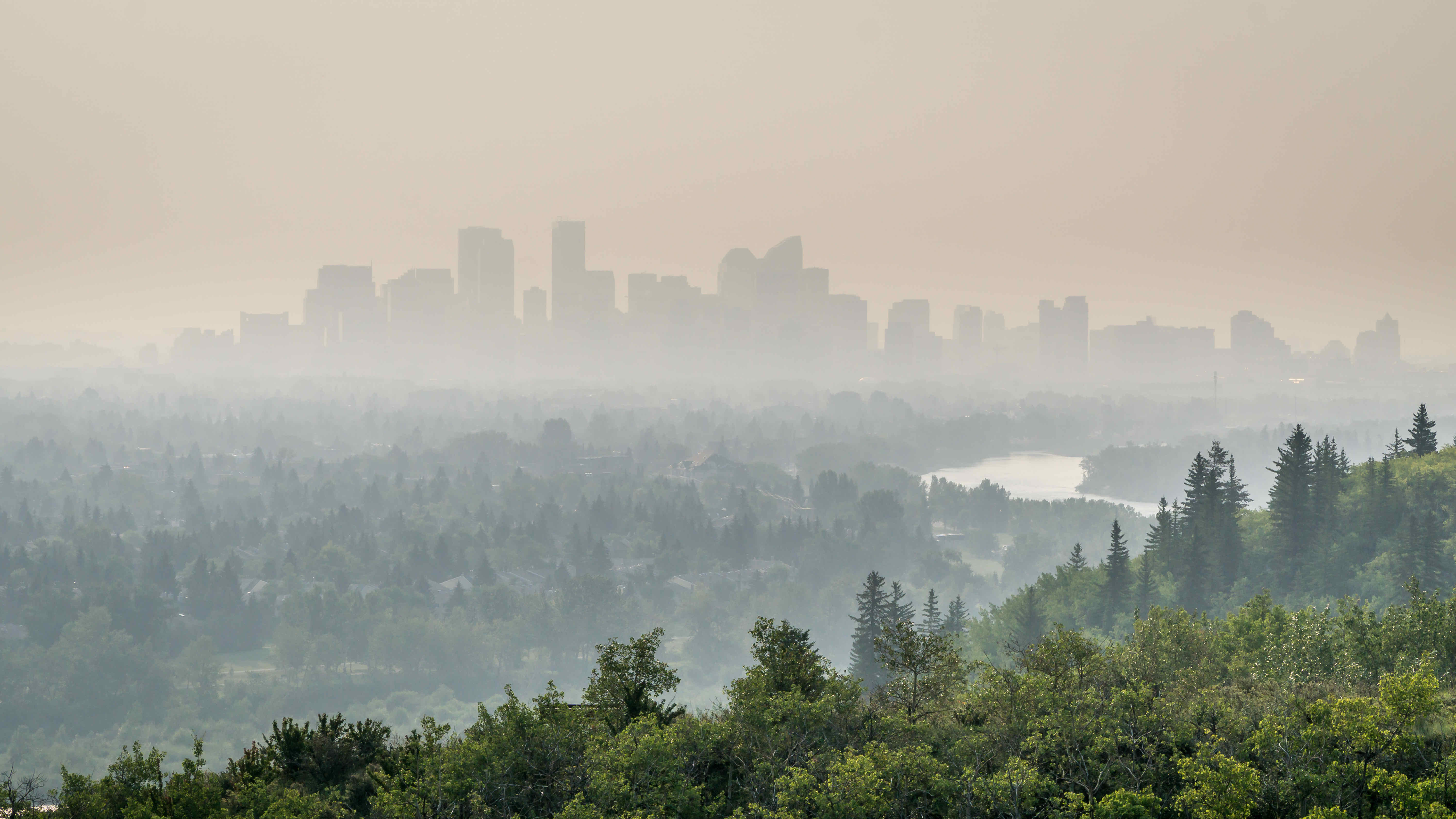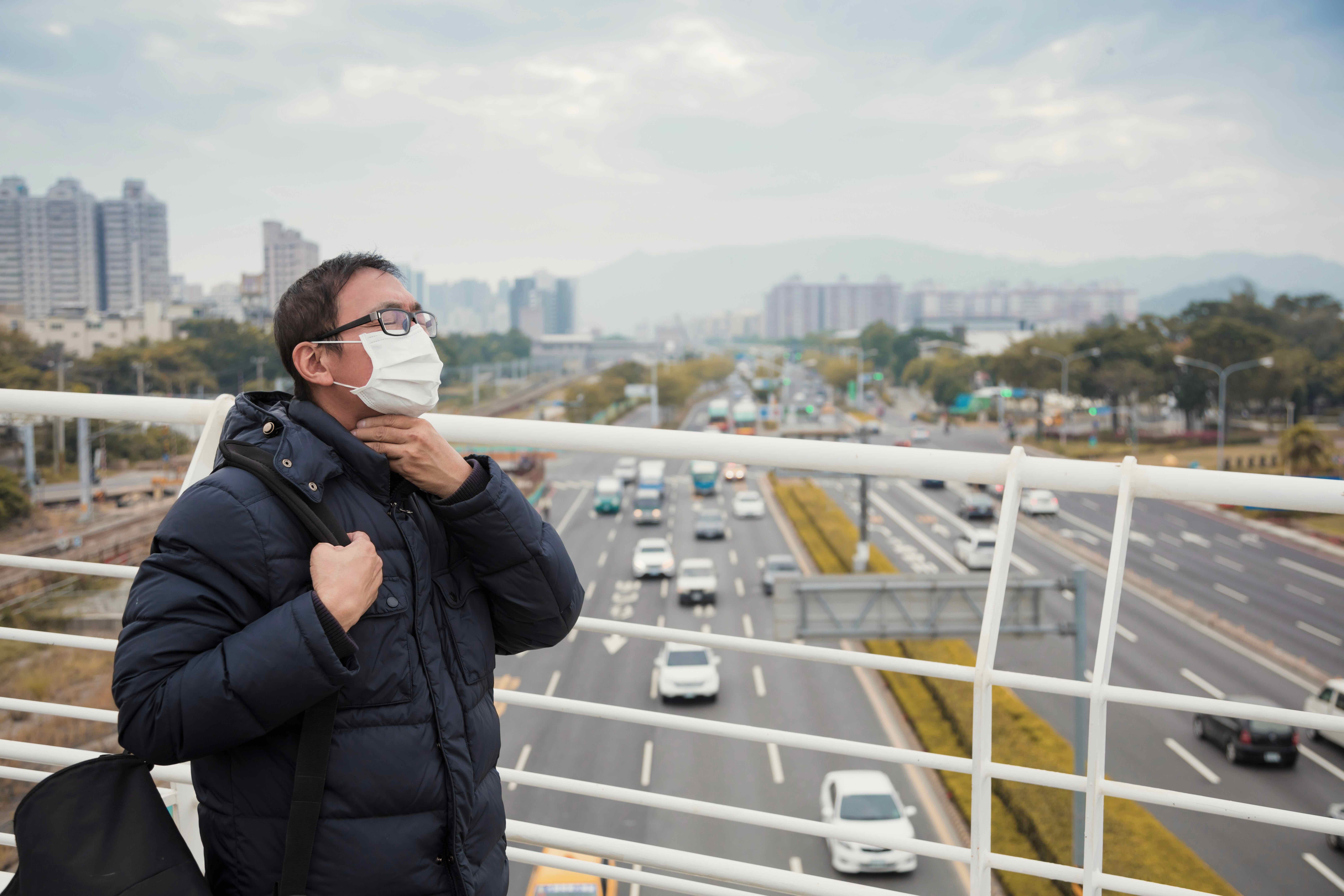
In August 2018, British Columbia declared a provincial state of emergency due to forest fires. At its peak, there were over 560 wildfires burning in the province. The smoke from the fires travelled thousands of kilometres, causing air quality warnings to be issued across BC, Alberta, and as far away as southern Manitoba.[1]
Record-breaking wildfire seasons have made headlines across Canada every summer in recent years. This will only continue as climate change makes summers longer and drier, leading to more and more wildfire risk for Canadians.
One of those growing risks is exposure to smoke. More wildfires mean more wildfire smoke, and more smoke means more smoke-related health problems. And since smoke travels easily, these health problems don’t only affect people who live in fire-prone areas.
“You don't need fire at your doorstep to be impacted,” says Jeff Eyamie, Air Quality Officer with Health Canada. “Wildfire smoke can transport all around the world. There's evidence that the fires from Fort McMurray [in 2016] generated smoke that traveled all the way to the UK and beyond.”

Read more: How does climate change affect wildfires?
When forest fire researcher Mike Flannigan looks ahead at what climate change means for wildfires in Canada, he doesn’t beat around the bush: “in a word, the future is smoky.”
Flannigan has been studying fire for over thirty years. His work, and the work of hundreds of other researchers, shows that climate change will worsen the three major factors that influence wildfires: having dry fuel to burn, frequent lightning strikes that start fires, and dry, windy weather that fans the flames.
Under climate change, we’ll be seeing more extreme events from flooding to wildfires and more. And it’s important to realize that these risks aren’t separate. Even after spring flooding, summer heat can kick in rapidly, drying out the newly grown vegetation that a wet spring enabled. This process can create new fuels and dangerous conditions for wildfires.[2]
To learn more about wildfires and what we can do to manage them, see our Forest Fires and Climate Change article.

How does wildfire smoke affect our health?
Think of a smog-filled industrial city like Beijing. The air in these cities is often filled with very tiny particles that are an especially dangerous type of air pollution. The extremely small size of these particles means that they are easily carried by wind across large distances, and can also penetrate deeply into your lungs, causing irritation and inflammation.
Dense smoke from wildfires can have fifty times the amount of these tiny particles than the World Health Organization’s guidelines for safe exposure. So when we talk about wildfire smoke as a health issue, we’re essentially talking about a type of very intense air pollution.
By far, the biggest health impact from wildfire smoke is difficulty breathing. Emergency room visits spike during wildfires as people experience shortness of breath, coughing and irritation, worsened asthma, and other breathing problems.
We all breathe, which means that all of us are vulnerable to the impacts of wildfire smoke. And a majority of us are especially vulnerable, including:
- People who work, play, or spend significant time outdoors
- People with asthma, allergies, or certain other health issues
- People with limited economic means
- Children
- Older adults
- Pregnant people
Wildfire smoke impacts aren’t limited to breathing issues. According to Eyamie, “there's now evidence to connect wildfire smoke with low birth weight, stroke, cardiovascular disease and all kinds of other health impacts.”
The good news is that when the smoke goes away, these short-term risks usually go away too. Scientists are also conducting research to determine what long-term impacts are caused by short-term smoke exposure.[3] But since the short-term impacts can be serious, it’s important to protect yourself and others during a smoke event.
Read More: De-mystifying smoke
Although we know smoke can be extremely harmful, there are aspects that scientists are still working to understand. As Eyamie explains, “smoke is a really difficult thing to quantify. Every fire is a little bit different.” Whether smoke travels depends on many factors such as temperature and wind, making it hard to model and study.[4]
Eyamie says that since smoke is a product of incomplete combustion, “the chemical composition of smoke is always different. That makes it very difficult to say it's going to act the same way from one fire to the next.”
Gaining a better understanding of smoke will help us to better understand its effect on health. For example, we know that smoke can affect the cardiovascular system. The inflammation that smoke pollution causes can increase the risk for blood clots and can also impact the nervous system. But there’s lots more research to be done to fully understand smoke’s impact on cardiovascular health.
Scientists are also working on determining how short-term smoke exposure affects the immune system, including the development of allergies or asthma in children. [5]
Community health & wildfires
Smoke doesn’t only have physical health impacts. When much of BC was ablaze in 2018, the Canadian Mental Health Association ramped up its communications efforts because there are well-known links between wildfire smoke and anxiety, depression, and other challenges.[6] These linkages are serious enough that various provincial governments in Canada have developed mental health strategies for responding to wildfires.
Wildfire smoke is particularly challenging for remote and rural communities. “If you are in an isolated community, like a northern First Nation community that's only accessible by air, it can be very isolating to be in a prolonged smoke event, where you can't really move. You can't do your traditional activities outdoors,” says Eyamie. Smoke events make everyday life harder in places where services are already limited, and if evacuation is needed, the process can be extremely hard on people.
Read more: Evacuations and Community Health
Forest fires don’t just cause physical and mental health impacts from smoke inhalation. They also have real, and often devastating, psychological and social health impacts from the disruptions they cause to normal life. “I think we're just scratching the surface of building an evidence base around what mental health impacts really are around wildfires,” says Eyamie.
From the 2016 Fort McMurray fires, there is evidence showing higher levels of stress, anxiety, depression, PTSD and substance abuse following the disaster.[7]
Many mental health impacts are worsened by the evacuation process, as people are uprooted from their homes and placed in unfamiliar situations. In short, disaster responses themselves can be traumatic. This is why it’s vital that emergency responses include mental health and social supports during and after a fire.[8] For Indigenous communities in particular, service delivery needs to be flexible and culturally relevant.[9]
Watch our video Wildfires & Community Health to learn more.
How to stay safe
So what should you do when the sky is eerily grey and filled with smoke? There are a few simple things you can do to make wildfire season safer.
Above all, be aware. During wildfire season, you can see how smoke is moving across Canada through a website called FireWork. This handy wildfire smoke prediction system, developed by Environment and Climate Change Canada, is an easy way to understand how wildfire smoke might affect your community.
Another great tool to assess your risk is the Air Quality Health Index, or AQHI. It provides a snapshot of air quality in your region, rated from low to high risk. Just like we pay attention to the UV index on a hot summer day, keeping an eye on the AQHI can help you monitor how wildfire smoke might affect your health.
When wildfire smoke poses health risks, Eyamie recommends three key things. First, reduce exposure to the smoke. “You do that by staying away from it. You do that by inhaling it less, meaning don't conduct strenuous activity outdoors.” Eyamie says that staying indoors is usually the best option.
Second, try filtering the air. “Using HEPA filtration is a great way to do that in a confined space,” says Eyamie. If you’re driving, close the windows and set the ventilation system to recirculate.
And third, seek medical assistance. “If you are feeling discomfort, if you feel like you're starting to exhibit some symptoms and it's from smoke, get help,” says Eyamie. Monitor others who might be vulnerable, such as children, the elderly, or people with lung or heart conditions.
Read more: Do face masks work?"
It might feel natural to put on a simple face mask to deal with heavy smoke or pollution. Unfortunately, there’s a lot of conflicting information out there about whether face masks actually reduce how much pollution you’re inhaling. “Keep in mind, you're covering the things that you use to breathe,” says Eyamie.
One study on consumer face masks in China found that even if the mask itself is good quality, there can be air leaks of up to 68% depending on how a mask fits your face.[10] As Eyamie says, “the common view is that a mask is not that helpful. It's more of a placebo than anything.”
While a mask rated N95 might be useful, the best protection is simply limiting smoke exposure by staying indoors and avoiding physical activity.
Reducing wildfires
In the big picture, the real challenge is how to reduce forest fire smoke in the first place. That means reducing wildfires, especially through better forest management. Eyamie explains, “we have to manage our forests intelligently, with fire as part of forest management. We have to welcome fire as a creative force within the ecosystem.”
At the same time, it’s vital that we reduce the number of human-caused wildfires - by respecting fire bans, for example. Almost half of wildfires are caused by humans, which means there’s a lot we can do to stop them.
But regardless of how well we manage wildfires, there’s no denying we’ll be seeing more of them in the years to come. That’s why it’s more important than ever to cut our fossil fuel emissions. The more effort we put into reducing climate change and growing sustainable communities, the less those communities will be impacted in the long run.
References
- Postmedia News and the Canadian Press, “B.C. Declares State of Emergency as Heavy Smoke from Its Wildfires Blanket Alberta Cities,” National Post, August 15, 2018.
- Regional District of Okanagan-Similkameen. "From Floods to Fire: Be Fire Smart!"
- Robin Marks, “For Many, No Long-Term Health Impacts from Wildfire Smoke, But More Studies Needed,” University of California San Francisco (blog), October 24, 2017.
- Black, C., Y. Tesfaigzi, J. A. Bassein, and L. A. Miller. “Wildfire Smoke Exposure and Human Health: Significant Gaps in Research for a Growing Public Health Issue.” Environmental Toxicology and Pharmacology 55 (October 2017): 186–95. https://doi.org/10.1016/j.etap.2017.08.022.
- Robin Marks, “For Many, No Long-Term Health Impacts from Wildfire Smoke, But More Studies Needed,” University of California San Francisco (blog), October 24, 2017.
- Tiffany Crawford, “B.C. Wildfires 2018: Mental Health a Concern as Smoke Chokes Province,” Vancouver Sun, August 23, 2018.
- Agyapong, Vincent I. O., Michal Juhás, Matthew R. G. Brown, Joy Omege, Edward Denga, Bernard Nwaka, Idowu Akinjise, et al. “Prevalence Rates and Correlates of Probable Major Depressive Disorder in Residents of Fort McMurray 6 Months After a Wildfire.” International Journal of Mental Health and Addiction 17, no. 1 (February 1, 2019): 120–36. https://doi.org/10.1007/s11469-018-0004-8.
- Felix, Erika D., and Walid Afifi. “The Role of Social Support on Mental Health After Multiple Wildfire Disasters.” Journal of Community Psychology 43, no. 2 (2015): 156–70. https://doi.org/10.1002/jcop.21671.
- “From the Ashes: Reimagining Fire Safety and Emergency Management in Indigenous Communities. Report of the Standing Committee on Indigenous and Northern Affairs.,” June 12, 2018.
- Caroline Crist, “Face Masks Available to Consumers May Be Ineffective against Air Pollution,” Reuters, May 3, 2018.
Recommended Article Citation
Climate Atlas of Canada. (n.d.) Wildfire Smoke and Climate Change. Prairie Climate Centre. https://climateatlas.ca/wildfire-smoke-and-climate-change









.png)


